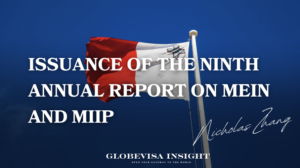Post
- Chen, Siren
- Chen, Siren
Trump, Greenland, and the American Dream: Debunking the Myth of Easy Immigration
The claim that “immigrate to Greenland with just US$20,000” has no basis in any legitimate immigration policies or laws—but the rumor persists, fueled by a surreal twist in geopolitics and the ongoing fascination with Greenland’s strategic importance.
Greenland’s Political Reality
Greenland, an autonomous territory of the Kingdom of Denmark, is not an independent country.Politically and diplomatically, it remains under Danish jurisdiction. This means that Greenland does not issue its own passports—residents of Greenland use Danish passports for international travel. Foreigners who dream of relocating to Greenland must apply for naturalization under Danish immigration laws.
And here’s the reality: Denmark has some of the strictest naturalization policies in the world.There is no investment-based citizenship program. Danish citizenship can only be obtained through birthright, marriage, or naturalization, which requires years of residency and rigorous qualifications. For foreigners, there are only a few ways to pursue Danish citizenship:
- Marrying a Danish citizen,
- Studying in Denmark,
- Working in Denmark, or
- Applying for political asylum.
Even for those who choose the second or third options, the hurdles are formidable. Temporary residence permits must be held for at least seven years, after which applicants may qualify for permanent residency—provided they meet stringent requirements. Proficiency in the Danish language is a must, and work visas are only granted to highly skilled professionals with specialized roles.Even under ideal circumstances, the process to naturalization takes at least nine years.
The Trump Connection: A Geopolitical Curiosity
Speculation about Greenland as a gateway to U.S. citizenship took on new life after U.S. President Donald Trump expressed an interest in acquiring Greenland. In 2019, Trump suggested that Greenland’s strategic location and vast natural resources made it an attractive target for U.S. acquisition. His remarks, first reported byThe Washington Post, caused global headlines and confusion. The Danish government categorically rejected the idea, with Denmark’s Prime Minister at the time calling the suggestion “absurd.” Greenland’s leaders also firmly stated that their homeland was “not for sale.”
Fast forward to December 2024.As U.S. President-elect, Trump doubled down on his interest in Greenland. He posted on social media that “for the security and freedom of the entire world, it is absolutely necessary for the United States to own and control Greenland.” His renewed push for Greenland’s acquisition reignited debates about the island’s geopolitical significance and led to a flurry of reactions. Just hours after Trump’s statement, the Danish government announced a dramatic increase in defense spending for Greenland. According to Denmark’s Minister of Defense, Troels Lund Poulsen, the plan—worth billions of Danish kroner (at least $1.5 billion)—includes purchasing two new patrol vessels, two long-range drones, and funding two sled dog teams for Arctic operations. Additional funds will also be allocated to increase staff at Greenland’s Arctic Command headquarters in Nuuk and to upgrade one of the island’s civilian airports to accommodate F-35 fighter jets.
Greenland’s Prime Minister, Mute Egede, responded diplomatically, reiterating that“Greenland is not for sale.” However, Egede also encouraged Greenlanders to remain open to collaboration and trade, particularly with their neighbors, hinting at a pragmatic approach to balancing local autonomy with international interest.
Myth vs. Reality: The $20,000 Shortcut
The combination of Trump’s public statements and Greenland’s geopolitical importance has fueled the myth that Greenland could become a stepping stone for foreigners seeking U.S. citizenship. The idea is rooted in speculation:if Greenland were somehow acquired by the U.S., its residents could potentially become U.S. citizens.This has led some to suggest that immigrating to Greenland now could position individuals for future benefits—if, and only if, Greenland were to transition to U.S. control.
However, this notion falls apart under scrutiny. First, there is no legal framework for Greenland to become U.S. territory, nor has any tangible progress been made toward such a goal. Trump’s comments remain rhetoric rather than actionable policy. Second, immigrating to Greenland requires navigating Denmark’s rigorous immigration system, which, as outlined earlier, is one of the most selective in the world. Denmark does not offer an easy path to citizenship for investors or economic migrants, and the process takes years of residency, language acquisition, and meeting strict qualifications.
Moreover, even if Greenland’s political status were to change—a scenario that seems highly unlikely—it’s improbable that Denmark would relinquish control without significant global opposition. Greenland’s vast resources, including rare earth minerals, and its strategic location in the Arctic make it a critical asset for Denmark and NATO. Any potential transfer of sovereignty would involve a protracted international process, making the idea of a $20,000 shortcut a baseless fantasy.
The Bigger Picture: Greenland’s Strategic Importance
Greenland’s sudden emergence as a point of geopolitical intrigue is no accident. The Arctic region is increasingly important due to its untapped resources and strategic value as climate change melts ice, opening new shipping routes and access to minerals. For Denmark, Greenland represents a crucial part of its national security and Arctic strategy. For the U.S., the island offers potential military and economic advantages.
Trump’s statements, while controversial, have brought attention to Greenland’s significance in global politics. Denmark’s swift response to bolster defense spending in Greenland demonstrates how seriously it takes the island’s security and autonomy. Greenland’s leaders, too, are navigating this increased attention carefully, balancing openness to international trade with the need to protect their sovereignty.
Conclusion: A Modern Myth
The idea of “$20,000 to immigrate to Greenland” as a pathway to U.S. citizenship may sound enticing, but it is firmly in the realm of myth. Immigrating to Greenland requires meeting Denmark’s demanding immigration laws, which offer no shortcuts. Trump’s renewed push for U.S. control over Greenland adds an intriguing twist, but it remains speculative at best. For now, Greenland is not for sale—and the dream of a Greenland shortcut to American citizenship is nothing more than wishful thinking fueled by political theater and misinformation.
Recent Posts
Comments



